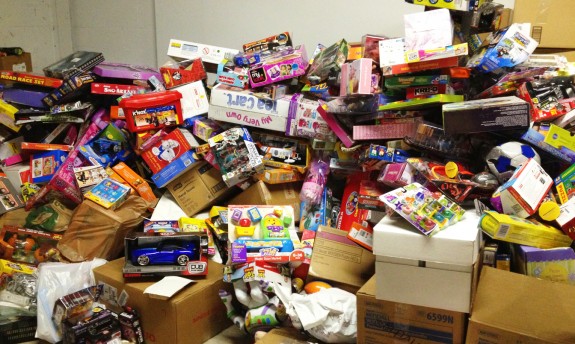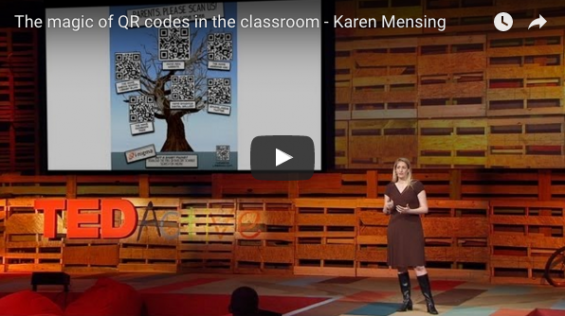
Ever sent clothing or toys in response to a disaster? Here’s what probably happened to it
So many of us have been moved to mail a box of clothes, toiletries, food or toys after hearing about a natural disaster or tragic event. But humanitarian logistics expert Dale Herzog says: Ask yourself three questions before sending another box into the chaos.
In the bleak winter days after the Sandy Hook Elementary School shooting in 2012, a town in shock after losing 20 children and six adults faced down intrusive reporters, political opportunists — and an outpouring of stuff. Thousands of boxes of Christmas toys, school supplies, gifts and clothing were sent to Newtown, Connecticut, along with over half a million cards, letters and paper snowflakes. Something like 65,000 teddy bears were mailed there, more than 1,000 of them life-sized.
It was a tremendous gesture of love from people around the world, but the logistical challenges presented by these gifts stretched residents to the breaking point. Newtown is a small, semi-rural town made up of villages, with a total population of just 27,000. With its limited postal resources, many other public employees — EMS, police, firefighters — and volunteers from surrounding post offices had to be brought in to handle all the stuff. At one point, the donations occupied 80,000 square feet of floor space stacked tightly together and standing eight feet high. During a time in which their community was struggling with unbearable grief, residents were forced to worry about what to do with this avalanche of packages, letters and cards.
The influx of unsolicited, and mostly unwanted, donations clog shelters, airport tarmacs and warehouses and drain the time and energy of the willing but scarce volunteers.
This situation isn’t unique to Sandy Hook. I worked at UPS transportation logistics for 41 years, and my last 11 years were devoted to humanitarian logistics. (I retired at the end of August 2018.) I was deployed in the wake of several disasters — including the 2016 floods in Louisiana and Hurricanes Harvey, Matthew and Joaquin — and I can give you so many examples about the deluge of unsolicited, and mostly unwanted, donations triggered by catastrophic events.
In my years on the job, I came to think of it as “the disaster within the disaster.” In every case, I saw how this second disaster made it nearly impossible for humanitarian responders to run efficient relief operations. The influx of donations clogged shelters, airport tarmacs and warehouses, and drained the time and energy of the willing but scarce volunteers. And if you’re wondering why relief organizations don’t just give the extra stuff to others that could use it, think about it: In the middle of their own unfolding disaster, they don’t have the labor, facilities or equipment to repackage and re-route the unsolicited stuff.
But why does this disaster within the disaster happen? Grief and empathy are primary motivations. We watch the news, and we’re so moved and overwhelmed when we see other people hurting. We feel compelled to do something to help.
Unfortunately, this desire too often takes the form of gathering what I refer to as “house-old” stuff. We empty our closets, garages, attics and pantries, thinking, “These people lost everything, so let me send anything!” After we’ve sent our stuff, we may feel a mild glow from having done our part — not realizing that 20,000 others did the same thing. What starts as an honest expression of goodwill almost always ends up causing complete chaos. To paraphrase my favorite line from the movie Jurassic Park, people get so preoccupied with whether or not they could, they don’t stop to think if they should.
After Hurricane Harvey hit Houston in 2017, one retailer donated 40,000 ladies’ belts. I wonder: were there that many people suffering from beltlessness after the storm?
Not all donations come from admirable impulses. Some corporations and small businesses view tragedy as an opportunity for gain. After disasters strike, it’s not uncommon for companies to jump at the chance to unload their aging inventory. Not only do they receive a tax break, they gain credit for appearing to be concerned and attentive. Not every company acts irresponsibly — many donate the right things at the right time — but I can share countless stories about businesses acting out of self-interest.
For example, there was the company that sent 10 full shipping containers of refrigerators — hundreds of fridges — to Haiti after the 2010 earthquake. It may sound generous, until you realize that most of the survivors were living in tents without electricity … and none of the appliances were wired to work in that country.
So many other inappropriate donations went to Haiti, including winter clothes (for a tropical island), potato chips, energy drinks, even tuxedos, according to a report from the UN Office for the Coordination of Humanitarian Affairs. More recently, after Hurricane Harvey hit Houston in 2017, I was stunned to see one retailer donate 40,000 ladies’ belts. I wonder: were there that many people suffering from beltlessness after the storm? In the wake of disaster, corporate donors have the most products to send — and they can be heroes or they can just create more mess.
Besides the time and effort to process these offerings, these items can also hurt the environment. After the 2010 earthquake in Haiti and the 2011 tsunami and earthquake in Japan, authorities reported that 60 percent of the donations they received were not needed, so they were discarded and dumped in landfills. There’s also the huge carbon footprint created by the planes, ships, trains and trucks used to ship all these goods to their destinations.
The flood of unsolicited stuff can even slow down the economic recovery of an entire region or country. This is a very sensitive issue for relief organizations — balancing the immediate needs of emergency relief while doing their best not to harm the local economy. While on assignment after Hurricane Matthew devastated Haiti in 2016, I talked to many leaders in the private sector. A common complaint from them was that many of the items that had been donated and then given away for free were things that could have been purchased locally to help rebuild the economy. They also usually told me that no one from the major relief and response organizations or from donor retailers had contacted them first. (Operational protocols for private sector and relief organizations are being established now so these problems can be avoided in the future.)
The next time you feel moved to send your stuff after a catastrophe, please ask yourself these three simple questions:
1. “Is this stuff wanted?” Please note: I use the word “wanted,” not “needed,” and there is a difference between the two. After natural disasters, many people do lose everything, but it’s much better to let them — or the organizations working directly with them — decide what is necessary and must be replaced first.
2. “How will this stuff get there?”
3. “How will the stuff get distributed after it arrives at its destination?”
Here’s one final story that ties these questions together. Following Hurricane Harvey in 2017, a teacher from outside Texas contacted me because her 7th-grade students had held a relief drive. They’d collected seven pallets’ worth of donations, the equivalent of 300 average-sized moving boxes, containing used clothes, food, baby items, pet food and toys, human toys, new and used car seats, games — basically anything you could think of that’s stored in people’s closets, garages, pantries, attics and bathrooms. She wanted to know if UPS could provide transportation to Texas for this stuff.
I was already working with multiple aid organizations in Harris County, so I was very aware of what was needed. I told her the contributions did not qualify as “emergency relief.” She was furious. She told me her students would be so devastated and disappointed, and I apologized. Her final words floored me. She said, “By God, we’re getting this stuff delivered to Houston even if the parents have foot the bill for shipping!” And they did just that, sending seven more pallets of unwanted stuff into the chaos.
If she’d asked my three questions first, the students’ efforts could have led to a totally different kind of drive. What if they’d gathered all the stuff, sold it at a yard sale, and then sent the proceeds via check or gift cards to a relief organization? I know that donating money seems impersonal; there’s also the fear of how easily cash might be misused.
Still, monetary donations remain the most efficient way to help, so do a little research and find a reputable charitable organization to give to. Please understand that disaster response is fluid, and on-the-ground demands are constantly changing and evolving. The best way for humanitarian groups and relief organizations to address them is by providing them with flexibility — and that means funds to buy the right supplies at the right time and to buy them in bulk (and locally when possible).
If you want to tell people you’re thinking about them or share a message of love or encouragement, do it virtually. Physical cards or stuffed animals are not what’s needed. Social media makes sending uplifting messages really easy to do.
Everyone from CEOs to kindergartners needs to learn how to give responsibly. Tell your friends, family, neighbors, colleagues and classmates that money is the most effective item to send.
In fact, technology could help with this problem in other ways too, to collect and bundle donations for the most efficient giving. I’ve been working with representatives from more than 20 organizations to determine the mutual needs of donors and relief organizations, and we’re designing a donor management system (DMS) — kind of like a gift registry for disasters. Our collective dream is a DMS where a donors can buy a specific item online (say, a case of bleach) from a participating retailer. The retailer can collect and bundle many online donations together, and then report out what they have. A retailer could say, for example, “we’ve seen 100 cases of bleach purchased, so we can offer 2 full pallets of bleach to any of the organizations in the DMS.” We’ve determined the system requirements, and it should be ready for development by the end of September 2018.
Why is this DMS needed? Because we’re human. Sometimes it just feels more satisfying to donate a tangible thing than to write a check. And anything that encourages people to donate in times of need, I’m in favor of. Our DMS offers an easier way to handle donated goods in bulk — not by the mixed bagful but by the pallet load. We think the big-box retailers will embrace this kind of shift in distribution. We envision the online experience to be controlled by the retailer, who’d be updated daily by the Emergency Operations Command (EOC) and get reports that reflect the real-time needs on the ground. Of course, this system will take investment and participation from the government, private sector and NGOs. But we can’t wait for the next disaster to establish it.
Technology is only part of the solution to the disaster within the disaster, but there’s something all of us can start doing now. Everyone from CEOs to kindergartners needs to learn how to give responsibly. As part of disaster-management efforts, government officials must start telling the public not to send unsolicited stuff. Companies must not use catastrophes as opportunities to offload old inventory, and when they do, they should be publicly called out for bad behavior. And you can talk to your friends, family, neighbors, colleagues and classmates, and tell them that money is the most effective item to send. When we all make better decisions, disaster survivors will be able to get the help they really need and start rebuilding their lives.
Watch his TED@UPS talk here:
ABOUT THE AUTHOR
Dale Herzog is a logistics and supply chain engineer at the UPS Foundation. He held many operational and industrial engineering positions throughout a 41-year career at UPS. He worked in the humanitarian sector for his last 11 years there, helping improve processes and data visibility for NGOs worldwide. He lives in Louisiana.
This piece was adapted for TED-Ed from this Ideas article.




